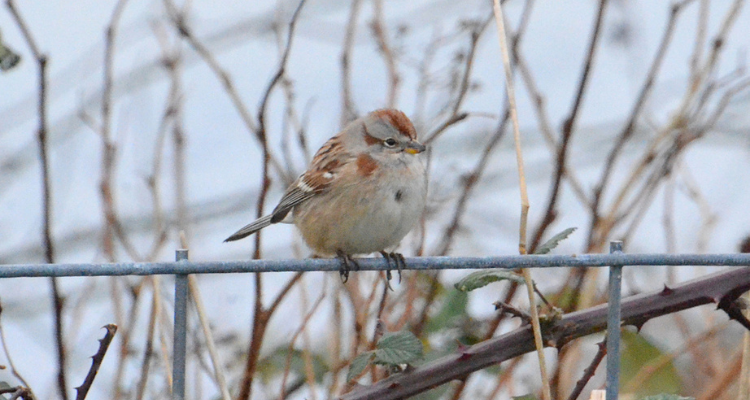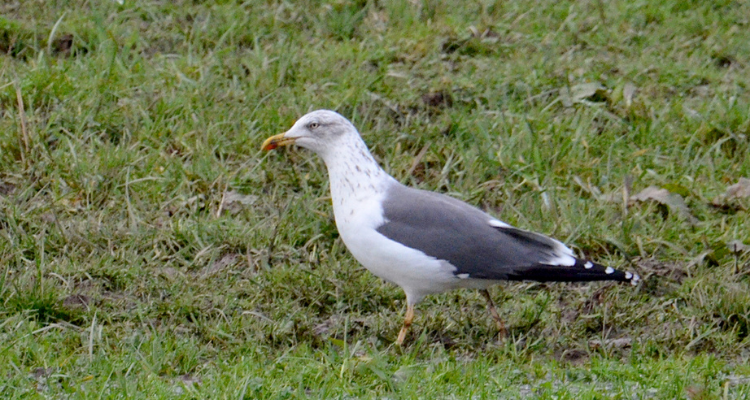
Red-shouldered hawk (Buteo lineatus). Photos by Mike Patterson
Every winter, citizen scientists across the nation bring out their observational skills and cameras to help survey birds for the National Audubon Society’s Christmas Bird Count, a census of birds in the Western Hemisphere performed annually. The data collected from the bird count—now in its 122nd year—is used to track long-term trends in the birding world.
The count follows a similar pattern from year to year. From Dec. 14 to Jan. 5, established communities select a single calendar day to hold their localized bird count and collect qualitative data.
In the Lower Columbia River region, there are four Christmas Bird Counts that could be considered local: Columbia Estuary, in Oregon and Washington; Wahkiakum, which also incorporates parts of Oregon and Washington; Tillamook, Oregon; and Leadbetter Pt., Washington. Of these, the longest running is the Tillamook Christmas Bird Count, which started in the 1950s.
In general, the Audubon’s Christmas Bird Count is one of the longest-running bird-monitoring programs in the world, according to Mike Patterson, a naturalist and ecological consultant from Astoria who has served as the compiler for the Columbia Estuary Count since 1990.
The census has a bit of a surprising history. It was originally introduced by conservationists in New York as an alternative to the tradition of going out and hunting birds on Christmas Day. In fact, Mike point outs, the word “birding” used to refer to the sport of shooting birds, not watching or identifying them. The passage of the Migratory Bird Treaty Act and other legislation that restricted and regulated the commercial hunting of native bird species sparked a change. By the 1960s, the term “birders” had been adopted as a synonym for birdwatchers.
“I still call myself a bird-watcher, because that’s what I do,” Mike says, adding he’s not as comfortable with the competitive side of birding. He simply enjoys being outside. Plus, he says, “Birds are easier to see than all the other organisms that I go looking for,” such as insects, lizards and salamanders.

American tree sparrow (Spizelloides arborea)
The Christmas Bird Count now happens in more than 20 countries and some counts have been running every year since the program was introduced. Although it is primarily supposed to be a fun event, there are some parameters in place to add consistency and increase the scientific rigor, Mike says. Each bird count has a central point that stays the same year to year, and the group surveys birds within a 7.5-mile radius of the point—or within a 15-mile-diameter circle.
One of Mike’s jobs as the count compiler is to divvy up the area for the Columbia Estuary Count into manageable portions and assign them to different participants. The more people, the smaller the chunks, but Mike also finds value in keeping his group to a collection of 15 to 20 people who are familiar with the area and the species of birds often found there. On the day of the count, they go out and cover their designated area and then report their numbers to the compiler.
All the data collected during the local bird counts is contributed to the official database on the Audubon website. A regional editor vets the data and follows up with the compiler if anything seems off. In some cases, if a particularly rare bird species is reported, the editor will ask for extra documentation. They’ll also write up a synopsis of what happened in the region for each annual bird count, and the data is published digitally.
The trend data from the Christmas Bird Count is accessible on the Audubon website. People can visit the site and look at the long-term changes of species. For some species, Mike says, “we’ve seen a range expansion in this region,” which is generally due to climate change, and “we’ve also seen a decrease in some species.” Additionally, people can track the correlation between bird sightings and external factors. For example, when the insecticide Dichlorodiphenyltrichloroethane (DDT) was introduced, there was a visible drop in Peregrine falcon and bald eagle observations. When DDT was banned, numbers popped back up.
As for short-term data, some years yield more interesting Christmas Bird Counts than others, Mike says. For this year’s Columbia Estuary Count, which took place Dec. 18, they documented about 125 different bird species, which is the average.
“The day was really nice, but we just didn’t hit anything really unusual that we didn’t already know about,” Mike says.

Orange-crowned warbler (Leiothlypis celata)
There are three main categories of bird species that can be spotted on the Oregon Coast:
- Residents, who live here year-round
- Neotropical migrants, who travel here from the tropics to breed during the summertime
- Nearctic migrants, who go to the Arctic to breed and then come here in the winter rather than traveling further south to Mexico or South America
This time of year, there are primarily residents and Nearctic migrants—as well as the occasional neotropical migrant holdover, who, for some reason, decided not to go south.
Currently, Mike has observed two interesting Nearctic birds in the Astoria area near Wireless Road. One is a lesser black-backed gull (Larus fuscus) and the other is an American tree sparrow (Spizelloides arborea). Both are unusual, he says, because they usually travel south to the Midwest, not the Pacific Northwest. However, this year, they’ve chosen to come this way.
Although the Christmas Bird Count is over for this year, there is still plenty of winter left for local and visitors to do some birdwatching. They can even partake in the citizen scientist aspect of the activity by contributing their sightings to sites like eBird and iNaturalist.
“You can do science basically every day you go out birding,” Mike says. “There are all sorts of places you can contribute data to the larger citizen science community.”
However, there’s also nothing wrong with simply getting outside and doing the activity without worrying about documentation.
“You don’t have to do any of that to go out and enjoy watching birds,” Mike says.

Lesser black-backed gull (Larus fuscus)
Comments